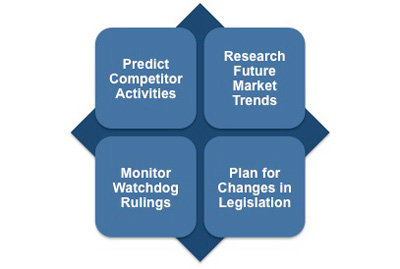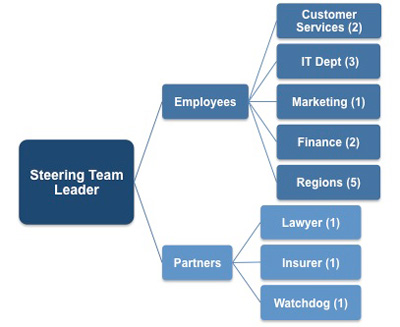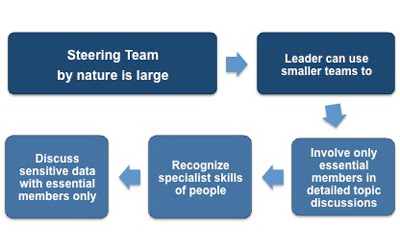Team Building - Steering Team Example
This team works within a large public utility company that was originally set up to provide water services. The company was originally owned by the state but has been privatized and now operates as a commercial organization.
The Water Services Regulator is responsible for ensuring that it continues to provide a quality service to all its customers and offers 'value for money.' This body ensures also that the water company adheres to all the required legislative regulations.
In the past, the company has operated with a traditional authoritarian management style, but it is endeavoring to alter this to a more commercial and empowered style of management through its change management program. All managers are expected to develop, coach, and mentor their staff so that they adopt the competencies required by the new commercial organization.
Many corporations make use of Steering Teams in their drive to stay ahead of competitors, research future market trends, and plan for changes in legislation that will affect them. Organizations that operate in highly regulated sectors also use this type of team to consider the impact of new rulings on the business. |
Steering Team Leader
In this scenario, you are the Business Development Executive of the water company. You have been an employee for two years. Your previous experience includes commercial legal expertise and management of deregulation in the leading telecommunications corporation. Your team's long-term objective is to identify the most profitable business opportunities that are available to the water company following the deregulation of their operations. The legislation removes the restrictions that previously meant that the organization could only sell water services.
The team also has a short-term objective to present a report on the potential opportunity and profitability of selling insurance to the water company's existing customer base of 14 million households.
Composition of Team
The Steering Team has some permanent members and some who have been brought in to look at specific issues. The permanent membership is made up of a senior person from each department within the company and the function of this group is to identify new business opportunities as described earlier.
In order to evaluate an opportunity, the team leader will need to bring in additional expertise from both inside and outside of the company.
For example, when investigating the possibility of selling insurance to its customer base the Steering Team would need to bring in representatives of:
• Customer Services Department
• IT Department
• Finance Department
• Regional Directors
• Marketing Department
• Law Firm
• Potential Partner Insurance Company
• Insurance Industry Regulator
This is a total of seventeen people as shown in the diagram below.
 |
Each team member has his or her own responsibilities and career path, and even the permanent members of the team are only assigned to it on a part-time basis. Your team size of seventeen people is on the large side, but it is necessary to have all the departments and partners represented who could be impacted by the decision to sell insurance. An informed decision simply cannot be made without involving all of these parties.
Challenges you are most likely to encounter
As team leader of the Steering Team your main challenge is to strike a balance between keeping the team focused on specific projects (in this case the decision to move into the insurance market) and allowing the team the freedom to explore other possible areas of interest to the business.
Define Success Criteria
The success criteria for this team are more difficult to specify than for the other examples we have looked at. Whilst the current project provides this team with a short-term goal, the output from this project needs to be properly defined and a deadline set. If this is not done, then it will be difficult to motivate the team members, who still have their normal day-to-day responsibilities, to allocate the necessary time and effort.
At the same time, the permanent members of the team need to be thinking strategically about the changing business environment, which will be continuously presenting new opportunities for the company.
These two distinct areas will need to be managed separately to prevent the team from either becoming totally focused on the current project or alternatively spending too much time on strategic issues at the expense of the current project. This Team Briefing Checklist walks you through the process of preparing a team briefing.
With this in mind, the best approach would be to keep these two functions separate.
All meetings and communication relating to the insurance project should be limited to that topic alone. This policy will need to be strictly enforced because there is always a tendency for this type of team to become a general talking shop and whilst some viable ideas may occasionally emerge it is an inefficient use of everyone's time.
There should be a formal procedure for bringing new opportunities to the attention of the team. This could involve a team member preparing a report that is then considered by a sub-group before being presented at a monthly strategy meeting at which individual projects are not discussed.
As leader of this team your responsibility is to concentrate all the efforts of the members on the current issue, whether it is an ongoing project or consideration of a new opportunity. This will involve setting meeting agendas that are highly focused, as well as making sure that the agenda is stuck to.
Lead by Example
Your own expertise and knowledge is well known within the group, but each individual is involved in your team because of the knowledge they can contribute, so you need to work towards gaining from them. Your own behavior will define and portray your expectations of others:
• Always arrive on time
• Prepare fully for each meeting
• Complete all your actions in a timely fashion
• Always issue accurate meeting minutes swiftly after each session
• Communicate clearly
• Ensure your commitment to the objective is evident in all your judgments
You will find that your role is comparable to that of a meeting 'Chair' where you have to listen to information being communicated and make a decision about what actions need to be taken. This decision needs to have the support of the team and should be arrived at through discussion and consensus.
One problem that you could come across in this scenario is that you will often be trying to control a meeting in which most of the attendees have as much or more seniority than you do. This can be made easier if the format of the meetings is as formal as you can make it and includes timed slots for each agenda item.
How to stay in control of meetings where you do not have seniority is dealt with in detail in the eBook 'Chairing a Meeting' which is available from this website.
Another key activity for you as leader of the Steering Team is to develop the support of the senior management for the team's investigation and ultimately their decision on its objective.
Value All Contributions
Wherever possible you should break up the team into sub-teams because most discussions will only impact on certain areas of the business and simply do not need everyone's involvement. This will not only save the company money but will minimize any resentment that team members feel as a result of being distracted from their other work.
 |
Only very rarely will you need to call the whole Steering Team together and you can use a variety of communications methods - email, secure intranet, and meeting minutes - to keep everyone informed of each sub-group's progress and findings.
Whenever you have sub-groups working in this way, you will need to make sure that the whole team, and not just the sub-group, knows the contribution of each team member. Many of the members of this team are motivated by the career-boosting visibility and recognition that team membership brings. Since you are not in a position to offer monetary rewards, you need to make sure that everyone feels as though their efforts are recognized as widely as possible within the company.
You can do this by communicating your appreciation for their input or the role they have played; it may be something as simple as saying 'Thank you' to the individual and in team situations. Listing all contributions in meeting minutes and making sure that any report summaries you send give full credit to the authors can also help achieve this.
Team Recognition and Reward
Involvement in this team is welcomed because each individual appreciates the benefit their inclusion provides for their career development.
The reward people are looking for in this type of team is career-boosting recognition. As team leader, your objective is to make sure that each participant feels that senior management will recognize his or her contribution as discussed earlier.
This doesn't mean that you don't need to bother showing your appreciation and acknowledging individuals' contributions. In fact, it is essential that you as leader of the team do recognize the role each individual has played at each stage of the investigation and the decision-making process.
Without this recognition from you, some team members may feel undervalued, and this could result in resentment and a lack of motivation. It is important that this recognition occurs within the Steering Team, at a senior level within the organization, and as appropriate within any partner organizations.
You may also be interested in:
Team Building in the Workplace | Team Building Principles | Different Types of Teams | Project Team Example | Support Team Example.



